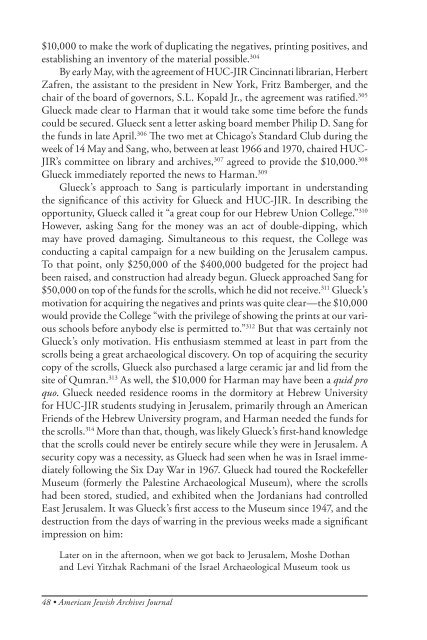The American Jewish Archives Journal, Volume LXI 2009, Number 1
The American Jewish Archives Journal, Volume LXI 2009, Number 1
The American Jewish Archives Journal, Volume LXI 2009, Number 1
Create successful ePaper yourself
Turn your PDF publications into a flip-book with our unique Google optimized e-Paper software.
$10,000 to make the work of duplicating the negatives, printing positives, and<br />
establishing an inventory of the material possible. 304<br />
By early May, with the agreement of HUC-JIR Cincinnati librarian, Herbert<br />
Zafren, the assistant to the president in New York, Fritz Bamberger, and the<br />
chair of the board of governors, S.L. Kopald Jr., the agreement was ratified. 305<br />
Glueck made clear to Harman that it would take some time before the funds<br />
could be secured. Glueck sent a letter asking board member Philip D. Sang for<br />
the funds in late April. 306 <strong>The</strong> two met at Chicago’s Standard Club during the<br />
week of 14 May and Sang, who, between at least 1966 and 1970, chaired HUC-<br />
JIR’s committee on library and archives, 307 agreed to provide the $10,000. 308<br />
Glueck immediately reported the news to Harman. 309<br />
Glueck’s approach to Sang is particularly important in understanding<br />
the significance of this activity for Glueck and HUC-JIR. In describing the<br />
opportunity, Glueck called it “a great coup for our Hebrew Union College.” 310<br />
However, asking Sang for the money was an act of double-dipping, which<br />
may have proved damaging. Simultaneous to this request, the College was<br />
conducting a capital campaign for a new building on the Jerusalem campus.<br />
To that point, only $250,000 of the $400,000 budgeted for the project had<br />
been raised, and construction had already begun. Glueck approached Sang for<br />
$50,000 on top of the funds for the scrolls, which he did not receive. 311 Glueck’s<br />
motivation for acquiring the negatives and prints was quite clear—the $10,000<br />
would provide the College “with the privilege of showing the prints at our various<br />
schools before anybody else is permitted to.” 312 But that was certainly not<br />
Glueck’s only motivation. His enthusiasm stemmed at least in part from the<br />
scrolls being a great archaeological discovery. On top of acquiring the security<br />
copy of the scrolls, Glueck also purchased a large ceramic jar and lid from the<br />
site of Qumran. 313 As well, the $10,000 for Harman may have been a quid pro<br />
quo. Glueck needed residence rooms in the dormitory at Hebrew University<br />
for HUC-JIR students studying in Jerusalem, primarily through an <strong>American</strong><br />
Friends of the Hebrew University program, and Harman needed the funds for<br />
the scrolls. 314 More than that, though, was likely Glueck’s first-hand knowledge<br />
that the scrolls could never be entirely secure while they were in Jerusalem. A<br />
security copy was a necessity, as Glueck had seen when he was in Israel immediately<br />
following the Six Day War in 1967. Glueck had toured the Rockefeller<br />
Museum (formerly the Palestine Archaeological Museum), where the scrolls<br />
had been stored, studied, and exhibited when the Jordanians had controlled<br />
East Jerusalem. It was Glueck’s first access to the Museum since 1947, and the<br />
destruction from the days of warring in the previous weeks made a significant<br />
impression on him:<br />
Later on in the afternoon, when we got back to Jerusalem, Moshe Dothan<br />
and Levi Yitzhak Rachmani of the Israel Archaeological Museum took us<br />
48 • <strong>American</strong> <strong>Jewish</strong> <strong>Archives</strong> <strong>Journal</strong>

















